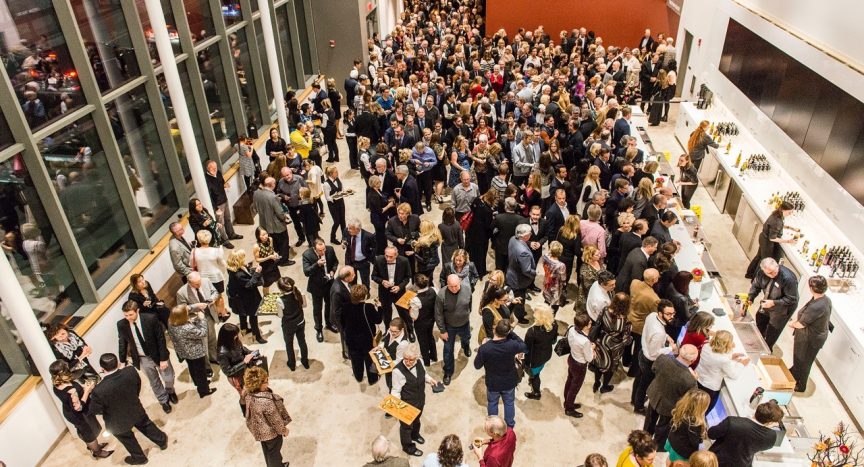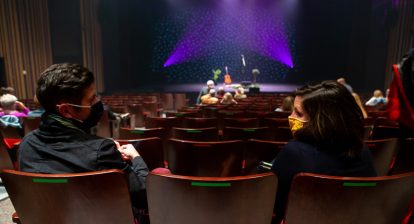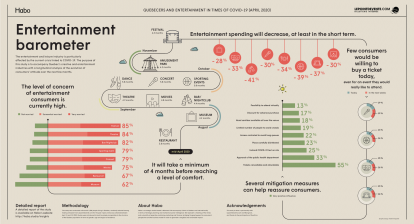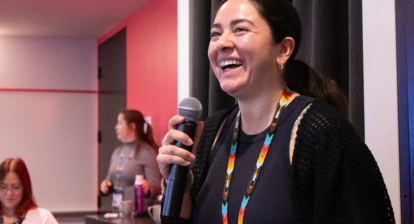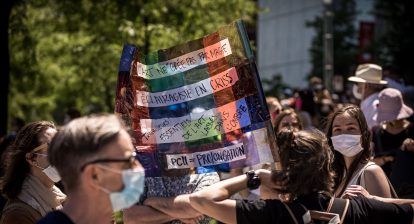Performing arts organizations and other live event organizers are currently exploring a range mitigation strategies to minimize risks of COVID contact as part of their reopening plans. In doing so, they have to consider both public health requirements and audiences’ perceptions of safety precautions.
In the last Chronicle of a Pandemic, we examined consumer survey findings related to anticipated timelines for audiences to return to live performances. These same surveys also include valuable information about audiences’ attitudes towards various safety precautions.
The 2020 Return to Live Events Survey and the Entertainment barometer asked respondents if given safety precautions would make them more likely or less likely to return to an event or to buy tickets. IMPACTS asked a different question: “What would make you feel safe and comfortable visiting a [insert organization type] again?” Even though their wording was different, all three surveys offer insights on the perceived safety of precautions, as well as on their positive or negative impact on the user experience.
Please stay home if you are not feeling well
The Entertainment Barometer found a flexible cancellation policy to be by far the most effective measure to reassure customers. 55% said fully cancellable and refundable tickets would have a very positive influence on their intention to purchase tickets. Other surveys did not ask about this simple, yet effective strategy.

Hand sanitizer: reassuring for now, but possibly on the decrease.
“Hand-washing or sanitizer stations throughout” is the number one factor that would increase likelihood to visit a festival or sports events, according to Enigma Research. “Availability of hand sanitizer” also ranked in the upper part of the IMPACTS chart. However, its perceived safety decreased significantly, from 43% on April 1st to and 34% on May 4th). “Availability of hand sanitizer” was found to be less reassuring than most other measures in the Entertainment Barometer. Only 18% reported it would have a very positive influence on their intent to purchase.
Physical distancing: in wait lines, absolutely; during the event, it depends
In all three datasets, “controlled access to avoid long lines” or “social distancing at entry and purchase points” was perceived as a positive precaution by a sizable proportion of respondents.
However, opinions are a little more divided when it comes to “social distancing between attendees” at large gatherings. 39% of Enigma respondents said it would make them more likely to attend, but another 23% said it would make them less likely to attend. Enforcement of social distancing may indeed prove much easier to implement at reserved-seating events than in an outdoor festival.
Reduced capacity: a public health requirement but not a particularly effective sales pitch
Implementing physical distancing within a theatre will force performing arts organizations to limit considerably the number of audience members at their events. But will a reduced capacity be in and of itself perceived as a reassuring measure by cultural consumers?
Limit on crowd or attendance tends to rank lower than most other safety precautions in the three consumer surveys.
- It is perceived as a safe measure by 19% of IMPACTS respondents.
- It would also have a positive influence on ticket buying intentions for 19% of Entertainment barometer respondents.
- “Events limited to small sizes to allow more social distancing” would increase the likelihood of attending with 40% of Enigma respondents. However, another 20% said it would make them less likely to attend.
Based on these results, limits on attendance may have a stronger appeal to audiences from a fear of missing out perspective than on safety grounds.
Body temperature checks: neither audiences nor public health experts seem keen about it
“Onsite health monitoring (e.g. taking guest temperatures)” is second last among all safety measures assessed by IMPACTS respondents. As little as 13% reported it would make them feel safe and comfortable going to an event again.
In Enigma, “body temperature checks upon entry” would increase the likelihood of attending for 39% of respondents. However, it would also make 19% of respondents less likely to attend.
The Entertainment barometer did not ask consumers about temperature checks. Instead the survey asked about onsite instant COVID-19 testing. This was found to have a positive influence for 25% of respondents. However, rapid COVID-19 testing is still experimental. And “rapid” currently means results in less than 60 minutes. Fast enough to deliver results to patrons on their way out of the theatre…
Regardless of the chosen method and device, onsite health monitoring will take time. This extra time may translate into longer wait lines. And longer wait lines increase risks of contagion. Considering the costs of acquiring touchless temperature scanners, of training staff on how to use them, and then for implementing regular checks, this could well be an expensive and relatively ineffective precaution (at least, that’s what public health experts seem to think).
Cleaning and sanitation: just do it
Extreme sanitation is reported to increase the likelihood of attending in both Enigma (74%) and the Entertainment barometer (23%). However, as little as 10% of Impacts respondents said “knowing facility cleaning procedures” would make them feel more safe to return.
What sense can we make of this paradox?
If “telling” your patrons about your extreme sanitation procedures doesn’t really make them feel much safer, what will? Should you make your sanitation visible, for example by having staff sanitize high touch surfaces while audience members are in the venue? Before the COVID-19, no performing arts organization would ever have considered performing janitorial tasks with the audience in the house. But in the post-COVID era, who knows?
Other considerations
All three surveys provide a breakdown of their findings by age groups. If your programming caters to a specific age group, you should take the time to delve into these findings.
Implementing safety precautions could prove to be complex and expensive. For more guidance, you may consult the Event Safety Alliance’s Event Reopening Guide.
Sources:
IMPACTS Research & Development and partners, as cited by Colleen Dilenschneider in “Meeting Visitor Needs: What Will Make People Feel Safe by Age & Income”, May 6th, 2020.
Habo, Entertainment barometer: Quebecers and entertainment in times of COVID-19, April 29, 2020.
Enigma Research, 2020 Return to Live Events Survey, April 2020.
A Clean Slate for Reopening
CAPACOA invites you to join us for a conversation on reopening and public safety. Facing COVID-19 and the prospect of reopening undoubtedly presents challenges for different groups and regions. To better understand the needs and possible gaps, CAPACOA has invited a panel of responders from the performing arts community to evaluate the Events Safety Alliance Guide to Reopening. The panellist will provide perspectives from artists and artistic companies; agents and managers; festivals; and venue presenters.
All members and non-members of the performing arts sector are welcome to participate, listen, and share, on May 19th at 3:00 PM (ET).
We will hear from the following leaders:
- Raeesa Lalani, Prismatic Arts Festival
- Amelia Griffin, Propeller Dance
- Tom Kemp, The Feldman Agency
Moderated by Michele Emslie, CAPACOA President and Director of Programming/Front of House Manager at Yukon Arts Centre
The COVID-19 pandemic has brought a daily avalanche of constantly-shifting news, concerns, updates, and government responses. Presenters, agents, and artists are all trying to grasp a new and rapidly-evolving reality. This is why CAPACOA, with support from Ontario Presents, has determined to document the changing state of the situation, as you report it to us during our online gatherings. We hope that our weekly Chronicles of a Pandemic and the Performing Arts will help those of us in the sector, and those looking to support it, to grasp our unique situation as it continues to evolve.


